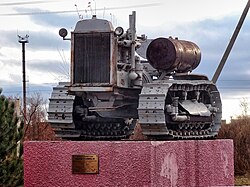Stalinez-60
| ЧТЗ | |
|---|---|

Stalinez-60 as a monument in Ukraine (2015) |
|
| Stalinez-60 | |
| Manufacturer: | Chelyabinsky Traktorny Zavod |
| Sales designation: | Сталинец-60, С-60 |
| Production period: | 1931-1937 |
| Engines: | Four cylinder petroleum engine |
| Traction: | about 50 kN |
| Length: | 4090 mm |
| Width: | 2395 mm |
| Height: | 2770 mm |
| Standard tires: | Chain drive |
| Empty weight: | 9500 kg |
| Previous model: | none |
| Successor: | Stalinez 65 |
The Stalinez-60 ( Russian Сталинец-60 , also abbreviated as S-60) is a Soviet heavy chain tractor that was designed and built in the Chelyabinsky Traktorny Sawod from 1931 . It was the first tractor of the newly built plant and an almost exact copy of the American Caterpillar Sixty . After almost 70,000 units had been built, production was switched to the successor Stalinez-65 with a diesel engine in 1937 .
Vehicle history

In the course of developing its first own tractor models, the Soviet Union also bought various chain tractors abroad in the 1920s for testing purposes. This included types from Hanomag (later built as Kommunar in the Malyshev factory ) as well as the Caterpillar Sixty, which had been built since 1919. The latter was initially procured in a small batch of just 20 machines. The tests were so promising, however, that a further 1,350 pieces were imported in 1929. The vehicle was particularly impressive because of its good off-road mobility.
Before series production began in the new tractor plant in Chelyabinsk , the design was modified. In particular, all dimensions were converted to the metric system, as the vehicle was originally manufactured in inches , as is common in the USA . There were also various other small changes. The fuel tank was always mounted on the left in the direction of travel, and a small additional tank was provided for the starter engine. In addition, the manufacturer's logos on the cooler sides changed. The S-60 could be equipped with a fabric top, there was no optional fixed metal roof like the model from Caterpillar.
The large-volume four-cylinder petroleum engine with a displacement of just under 20 liters was retained. Petroleum engines work like gasoline engines . In order to be able to burn the heavier petroleum, however, some special features are necessary. They are started with light fuels such as gasoline and brought to operating temperature. Only then is the preheated petroleum used. Petroleum was significantly cheaper than gasoline, especially in the USA, and was therefore used. Other Soviet tractors of the 1920s and 1930s that were replicas of US makes were also equipped with petroleum engines. Examples are the Fordson-Putilowez or the models from the Universal series .
The first prototype of the Stalinez-60 was completed in Chelyabinsk on February 15, 1931, more than two years before the tractor plant opened. In the same year, Caterpillar stopped production of the Sixty model and replaced it with the Diesel Sixty. The latter was later the inspiration for the Stalinez-65 . Series production of the Stalinez-60 began on May 15, 1933, and the factory was officially opened on June 1. By 1937, 68,997 or 69,100 tugs were manufactured, depending on the information, after which the Stalinez-65 was introduced. The Red Army also received tractors of this type, although it was actually designed for civilian use.
The Stalinez-60 was built in small numbers as a gas generator tug for operation with wood gas . Both the manufacturing plant and the NATI research institute engaged in the construction of wood gas generators from 1936. The reason was the shortage of liquid fuels, especially in remote northern regions of the Soviet Union. Wood, on the other hand, was plentiful. Only 264 of the Stalinez-60 were equipped for wood gas operation. Only with the successor was there a mass production of this modification, 7365 pieces were built from 1937, also with a view to the fuel shortage in World War II . After the war, this technology quickly disappeared in the Soviet Union as well.
Technical specifications
For the Stalinez-60.
- Engine: four cylinder four stroke petroleum engine
- Continuous power: 60 HP (44 kW)
- Maximum power: 72 HP (53 kW) at 650 min -1
- Displacement: 18,465 cm³
- Stroke: 216 mm
- Bore: 165 mm
- Transmission: manual transmission, 3 forward gears, 1 reverse gear
- Tank capacity: 390 l fuel
- Starter: auxiliary engine (gasoline engine)
- Pulling force: 44 kN, also indicated as 54 kN
- Top speed: 5.9 km / h, also stated 8.4 km / h
Dimensions and weights
- Length: 4090 mm
- Width: 2395 mm
- Height: 2770 mm above the exhaust
- Ground clearance: 405 mm
- Chain width: 500 mm
- Trench width that can be traversed: 700 mm
- Weight: 9.5 t
- Seats: 2
literature
- Uwe Siemer: Tractors from the Soviet Union. A chronicle from the beginning to 1990 . TRAKULA, Rastede. Without ISBN, around 2015.
- Jochen Vollert: TYAGATSHI - Soviet Full-tracked artillery tractors of World War II . Tankograd Publishing, Erlangen 2005.
Web links
Individual evidence
- ↑ a b c d e Jochen Vollert: TYAGATSHI - Soviet Full-tracked artillery tractors of World War II . P. 40 f.
- ↑ a b c Further website of the manufacturer on company history (Russian)
- ↑ The peculiarities of petroleum engines. Association for historical vehicles and equipment Unterriexingen. (PDF document)
- ↑ a b Data for the Stalinez-60 and Stalinez-65 (Russian)

